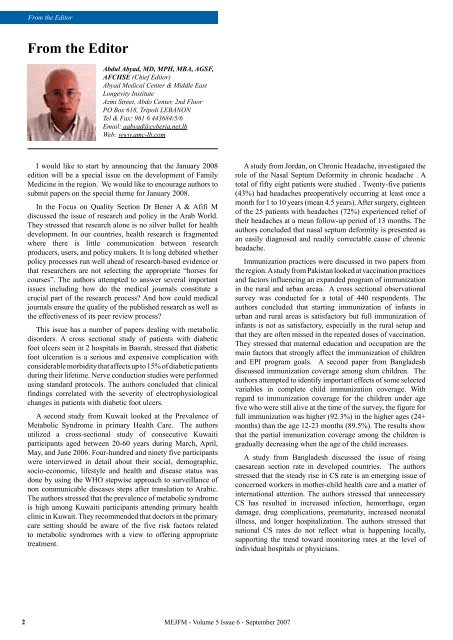Contents - Middle East Journal of Family Medicine
Contents - Middle East Journal of Family Medicine
Contents - Middle East Journal of Family Medicine
- No tags were found...
Create successful ePaper yourself
Turn your PDF publications into a flip-book with our unique Google optimized e-Paper software.
From the Editor<br />
From the Editor<br />
Abdul Abyad, MD, MPH, MBA, AGSF,<br />
AFCHSE (Chief Editor)<br />
Abyad Medical Center & <strong>Middle</strong> <strong>East</strong><br />
Longevity Institute<br />
Azmi Street, Abdo Center, 2nd Floor<br />
PO Box 618, Tripoli LEBANON<br />
Tel & Fax: 961 6 443684/5/6<br />
Email: aabyad@cyberia.net.lb<br />
Web: www.amc-lb.com<br />
I would like to start by announcing that the January 2008<br />
edition will be a special issue on the development <strong>of</strong> <strong>Family</strong><br />
<strong>Medicine</strong> in the region. We would like to encourage authors to<br />
submit papers on the special theme for January 2008.<br />
In the Focus on Quality Section Dr Bener A & Afifi M<br />
discussed the issue <strong>of</strong> research and policy in the Arab World.<br />
They stressed that research alone is no silver bullet for health<br />
development. In our countries, health research is fragmented<br />
where there is little communication between research<br />
producers, users, and policy makers. It is long debated whether<br />
policy processes run well ahead <strong>of</strong> research-based evidence or<br />
that researchers are not selecting the appropriate “horses for<br />
courses”. The authors attempted to answer several important<br />
issues including how do the medical journals constitute a<br />
crucial part <strong>of</strong> the research process And how could medical<br />
journals ensure the quality <strong>of</strong> the published research as well as<br />
the effectiveness <strong>of</strong> its peer review process<br />
This issue has a number <strong>of</strong> papers dealing with metabolic<br />
disorders. A cross sectional study <strong>of</strong> patients with diabetic<br />
foot ulcers seen in 2 hospitals in Basrah, stressed that diabetic<br />
foot ulceration is a serious and expensive complication with<br />
considerable morbidity that affects up to 15% <strong>of</strong> diabetic patients<br />
during their lifetime. Nerve conduction studies were performed<br />
using standard protocols. The authors concluded that clinical<br />
findings correlated with the severity <strong>of</strong> electrophysiological<br />
changes in patients with diabetic foot ulcers.<br />
A second study from Kuwait looked at the Prevalence <strong>of</strong><br />
Metabolic Syndrome in primary Health Care. The authors<br />
utilized a cross-sectional study <strong>of</strong> consecutive Kuwaiti<br />
participants aged between 20-60 years during March, April,<br />
May, and June 2006. Four-hundred and ninety five participants<br />
were interviewed in detail about their social, demographic,<br />
socio-economic, lifestyle and health and disease status was<br />
done by using the WHO stepwise approach to surveillance <strong>of</strong><br />
non communicable diseases steps after translation to Arabic.<br />
The authors stressed that the prevalence <strong>of</strong> metabolic syndrome<br />
is high among Kuwaiti participants attending primary health<br />
clinic in Kuwait. They recommended that doctors in the primary<br />
care setting should be aware <strong>of</strong> the five risk factors related<br />
to metabolic syndromes with a view to <strong>of</strong>fering appropriate<br />
treatment.<br />
A study from Jordan, on Chronic Headache, investigated the<br />
role <strong>of</strong> the Nasal Septum Deformity in chronic headache . A<br />
total <strong>of</strong> fifty eight patients were studied . Twenty-five patients<br />
(43%) had headaches preoperatively occurring at least once a<br />
month for 1 to 10 years (mean 4.5 years). After surgery, eighteen<br />
<strong>of</strong> the 25 patients with headaches (72%) experienced relief <strong>of</strong><br />
their headaches at a mean follow-up period <strong>of</strong> 13 months. The<br />
authors concluded that nasal septum deformity is presented as<br />
an easily diagnosed and readily correctable cause <strong>of</strong> chronic<br />
headache.<br />
Immunization practices were discussed in two papers from<br />
the region. A study from Pakistan looked at vaccination practices<br />
and factors influencing an expanded program <strong>of</strong> immunization<br />
in the rural and urban areaa. A cross sectional observational<br />
survey was conducted for a total <strong>of</strong> 440 respondents. The<br />
authors concluded that starting immunization <strong>of</strong> infants in<br />
urban and rural areas is satisfactory but full immunization <strong>of</strong><br />
infants is not as satisfactory, especially in the rural setup and<br />
that they are <strong>of</strong>ten missed in the repeated doses <strong>of</strong> vaccination.<br />
They stressed that maternal education and occupation are the<br />
main factors that strongly affect the immunization <strong>of</strong> children<br />
and EPI program goals. A second paper from Bangladesh<br />
discussed immunization coverage among slum children. The<br />
authors attempted to identify important effects <strong>of</strong> some selected<br />
variables in complete child immunization coverage. With<br />
regard to immunization coverage for the children under age<br />
five who were still alive at the time <strong>of</strong> the survey, the figure for<br />
full immunization was higher (92.3%) in the higher ages (24+<br />
months) than the age 12-23 months (89.5%). The results show<br />
that the partial immunization coverage among the children is<br />
gradually decreasing when the age <strong>of</strong> the child increases.<br />
A study from Bangladesh discussed the issue <strong>of</strong> rising<br />
caesarean section rate in developed countries. The authors<br />
stressed that the steady rise in CS rate is an emerging issue <strong>of</strong><br />
concerned workers in mother-child health care and a matter <strong>of</strong><br />
international attention. The authors stressed that unnecessary<br />
CS has resulted in increased infection, hemorrhage, organ<br />
damage, drug complications, prematurity, increased neonatal<br />
illness, and longer hospitalization. The authors stressed that<br />
national CS rates do not reflect what is happening locally,<br />
supporting the trend toward monitoring rates at the level <strong>of</strong><br />
individual hospitals or physicians.<br />
2<br />
MEJFM - Volume 5 Issue 6 - September 2007
















